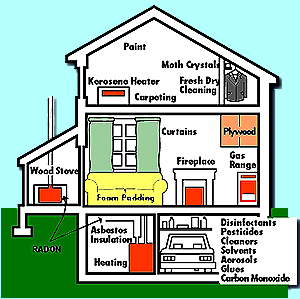Questions and Answers: Indoor Air Pollution
Select a question below to show answer
- What are garage vapors and toxic vapors?
- Gasoline vapors are toxic. There are two ways which gasoline fuel evaporates from your vehicle:
- Due to the increase in daily temperatures, the vapor in the fuel expands and leaks from the vehicle if the evaporative controls on the vehicle are not working properly. Evaporation for daily temperature changes occur each day for all vehicles with gasoline fuel in the tank, even when stationary.
- Evaporation from the fuel delivery system takes place when a hot engine is turned off and the vehicle is stationary. The vapors arise as the heat from the engine and hot exhaust reach the fuel system where fuel is no longer flowing. Older vehicles with carburetors (carburetor float bowls) contribute significantly to evaporated gasoline vapors.
- Quick Links to Information on Attached Garages:
-
- Indoor Air Pollution Arctic Science Journeys is a radio service highlighting science, culture, and the environment of the circumpolar north. Produced by the Alaska Sea Grant College Program and the University of Alaska Fairbanks.
- Building Code Amendment Justification Research: Poor Indoor Air Quality Mitigation Relative to Attached Garages (PDF). This paper reports on research that utilized the Sealed Housing for Evaporation Determination (SHED) method for measuring auto emissions in a confined space to facilitate measurement of "off-gassing" of automobiles in a simulated garage space. Results show there is adequate evidence that a pollutant source is likely to exist in the garage space, to the extent that migration of the pollutant into the living space needs to be mitigated. This data is used to justify the statement that building codes should require a dedicated exhaust vent (passive minimum) for any garage attached to a residential family unit.
- An excerpt from the summary of Architectural, Behavioral and Environmental Factors Associated with VOCs in Anchorage Homes (PDF); A. Schlapia, S. Morris, Document # 98-A504, presented at the 91st Annual Meeting of the Air & Waste Management Association (San Diego, CA) June 1998. Additional information about this study may be obtained by contacting Steve Morris, Municipality of Anchorage.
- What is Indoor Air Pollution?
- Indoor air pollution can be any number of pollutants. Radon, asbestos, tobacco smoke, solvents, cleaning solutions, carbon monoxide, mold, and fungus can pollute indoor air. Indoor air pollution sources include attached garages, new carpets and furniture, water leaks and condensation, chemical storage, poorly operating heaters, and is worsened by inadequate ventilation. Here are some facts:
- Indoor air pollution may exist at levels 2 to 5 times more than outdoor levels.
- Sometimes, the concentration indoors is 100 times the outdoor pollutant concentration.
- Studies indicate children spend more and more time indoors, and less and less outside.
- People may spend 90% of their time indoors. Because of this, indoor air pollution is now receiving a great amount of attention.
- What are the potential health effects?
- The health effects depend on the chemical, its concentration in the air, and the length of exposure. Long term health effects can include:
- cancer
- chronic bronchitis
- asthma
- decreased lung capacity and performance
- Health effects from short-term exposures to high concentrations of some toxicant:
- Short-term health effects can include:
- irritation of eyes, nose and throat, headaches
- dizziness and fatigue
- asthma attacks
- decreased reaction time and other nervous system impacts
- What are people doing about it?
- The United States Environmental Protection Agency (EPA) developed a strategy to reduce indoor air pollution. The EPA believes public policy dictates efforts taken to reduce people's exposures to potentially harmful hazardous indoor air pollutants. This will occur through use of current laws, and may include regulations. The EPA also plans to resolve indoor air problems through design, construction, operation, and maintenance of public buildings. Finally the EPA plans to implement effective research and development activities. See EPA's Indoor Air Quality Web page for additional information. Also see the EPA's indoor air pollution publication: "The Inside Story: A Guide to Indoor Air Pollution"
- Who do I contact at EPA regarding Indoor Air Quality?
- Note: DEC does not have the authority to regulate or monitor indoor air quality. For additional information about Indoor Air Quality, please contact EPA:
- Davis Zhen, US EPA, Region 10, 206-553-7660
- David Rowson, US EPA, Indoor Environments Division, Director, 202-343-9370


 Indicates an external site.
Indicates an external site.